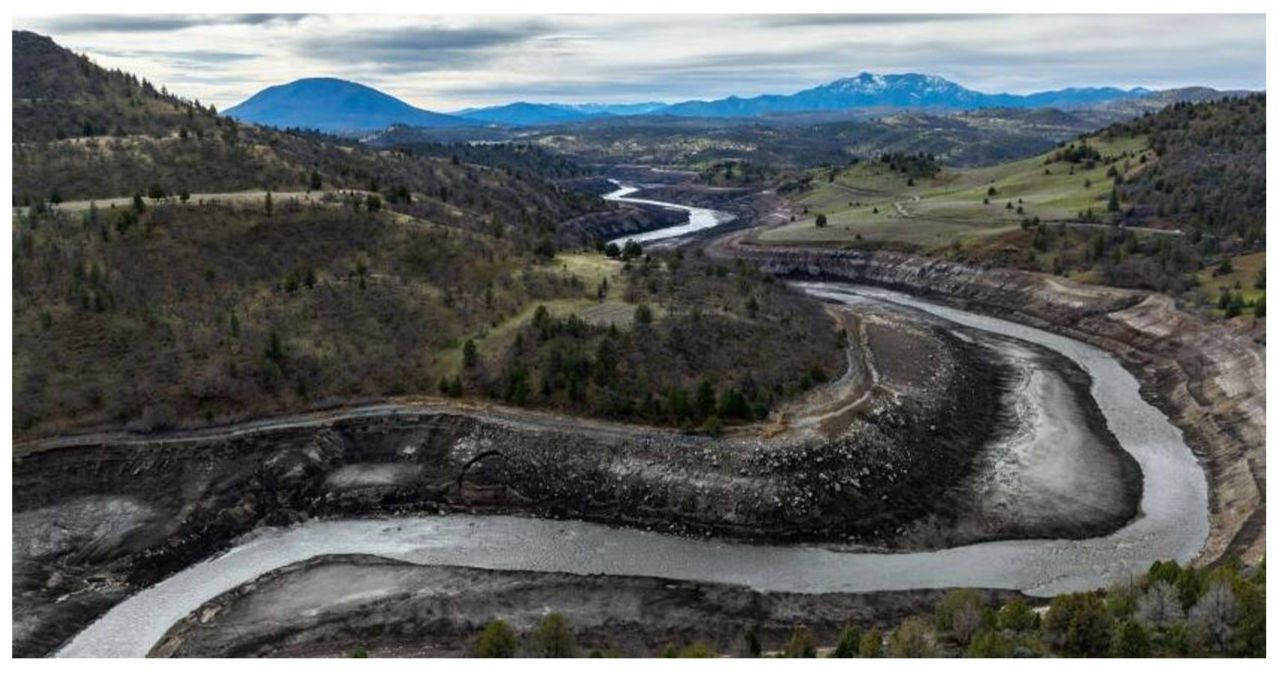In the vicinity of the California-Oregon border, reservoirs that previously submerged valleys have now been emptied, unveiling a barren landscape that had remained submerged for countless generations.
The sloping ground is now covered with a thick layer of muddy sediment, where workers have been scattering seeds and leaving behind meandering trails of footprints. Upon closer inspection, one can see that the cracked mud has become a fertile ground for seedlings to sprout, with tiny green shoots beginning to emerge.
Water is now flowing freely through tunnels in three dams, allowing the Klamath River to return to its original channel. This marks the first time in over a century that the river is able to flow unimpeded through miles of waterlogged lands.
Crews initiated the process of demolishing one of the three dams by using explosives and machinery earlier this month. As the extensive dismantling project progresses, an additional endeavor to restore the river to its natural state has recently commenced.
Leaf Hillman, a member of the Karuk Tribe, expressed his joy and satisfaction as he witnessed the long-awaited process of healing finally commencing. After dedicating over two decades to advocating for the removal of dams, Hillman described it as a beautiful thing and a beautiful feeling to witness this progress.
From his vantage point on a bluff, Hillman observed the murky, sediment-filled water gushing out of a tunnel and cascading downstream at Iron Gate Dam. He noted that although the appearance of the muddy water might not be pleasing to everyone, it actually indicates a positive development in terms of the reservoir’s condition. The presence of dead algae and accumulated debris in the reservoirs is now being flushed out, signifying an improvement in their overall health.
“It’s about time for this much-needed cleansing. The river has been slowly dying for years, suffocated by these dams,” Hillman expressed. “Witnessing the sediment being swept away is a beautiful sight, as the river is finally allowed to flow freely once again.”
In January, the reservoirs were emptied, resulting in the release of approximately 2.3 million tons of sediment into the river. This sudden increase in sediment has had a negative impact on the water quality, leading to the death of nonnative perch, bluegill, and bass that were introduced into the reservoirs for fishing purposes.
The river’s banks downstream from the dams are filled with dead fish, according to tribal leaders, biologists, and environmentalists. However, they argue that this was intentional and part of a larger plan. They firmly believe that the river will soon become a welcoming environment for salmon to swim upstream and spawn once again.
Hillman and other Indigenous activists dedicated years to protesting in order to restore the Klamath. Their efforts even extended to protesting outside a Scottish Power shareholders meeting in Edinburgh when the U.K. company owned PacifiCorp. Eventually, through negotiations, agreements were reached to remove the hydroelectric dams.
Between 1912 and the 1960s, structures were constructed without tribal consent. These structures not only blocked the salmon from reaching their crucial habitat but also resulted in the degradation of the river’s water quality. As a consequence, toxic algae blooms occurred in the reservoirs, and disease outbreaks ensued, leading to the death of numerous fish.
Hillman, a ceremonial leader and former Karuk vice chairperson, has played a crucial role in his tribe’s fisheries department since its inception in 1990. Throughout the years, he has witnessed a decline in salmon populations and the unfortunate occurrence of algae blooms in the river. These events have had a significant impact on tribal members who traditionally participate in water ceremonies.



